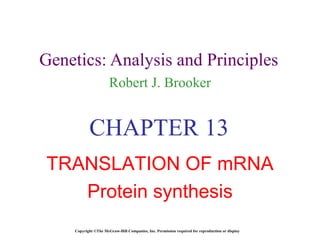More Related Content Similar to Translation brooker Similar to Translation brooker (20) 1. Genetics: Analysis and Principles Robert J. Brooker Copyright ©The McGraw-Hill Companies, Inc. Permission required for reproduction or display CHAPTER 13 TRANSLATION OF mRNA Protein synthesis 3. 13-16 Figure 13.2 Overview of gene expression Note that the start codon sets the reading frame for all remaining codons 10. 13-30 Figure 13.5 Condensation reaction releasing a water molecule Copyright ©The McGraw-Hill Companies, Inc. Permission required for reproduction or display Carboxyl group Amino group 11. 13-31 Figure 13.5 N terminal C terminal Copyright ©The McGraw-Hill Companies, Inc. Permission required for reproduction or display 18. 13-38 Figure 13.8 Copyright ©The McGraw-Hill Companies, Inc. Permission required for reproduction or display 19. 13-41 Wild type mutant A comparison of phenotype and genotype at the molecular, organismal and cellular levels Figure 13.9 26. 13-55 Figure 13.13 The amino acid is attached to the 3’ end by an ester bond tRNA charging 31. Copyright ©The McGraw-Hill Companies, Inc. Permission required for reproduction or display 13-60 Figure 13.15 Note: S or Svedberg units are not additive Synthesis and assembly of all ribosome components occurs in the cytoplasm 32. Copyright ©The McGraw-Hill Companies, Inc. Permission required for reproduction or display 13-61 Figure 13.15 The 40S and 60S subunits are assembled in the nucleolus Then exported to the cytoplasm Synthesized in the nucleus Produced in the cytosol Formed in the cytoplasm during translation 36. Copyright ©The McGraw-Hill Companies, Inc. Permission required for reproduction or display Figure 13.17 Initiator tRNA See animation on your CD 39. 13-68 Figure 13.18 Copyright ©The McGraw-Hill Companies, Inc. Permission required for reproduction or display 40. 13-69 Figure 13.18 70S initiation complex This marks the end of the first stage The only charged tRNA that enters through the P site All others enter through the A site Copyright ©The McGraw-Hill Companies, Inc. Permission required for reproduction or display 45. 13-74 Figure 13.20 The 23S rRNA (a component of the large subunit) is the actual peptidyl transferase Thus, the ribosome is a ribozyme! Copyright ©The McGraw-Hill Companies, Inc. Permission required for reproduction or display 46. 13-75 Figure 13.20 tRNAs at the P and A sites move into the E and P sites, respectively Copyright ©The McGraw-Hill Companies, Inc. Permission required for reproduction or display Max. 2 tRNAs bound to mRNA in a ribosome ! Peptide bond formation is catalyzed by rRNA, not by one of the proteins in the ribosome! 53. Sequence of Triplet form the genetic code and the mutations in a gene : Frameshift Mutations: By insertion/deletion of 1 or 2 nucleotiden 55. Mutations: Base changes Very harmful : - deletion / insertion of one base - deletion / insertion of two bases Especially in the beginning of a ORF/gene If at the end of a gene, the ‘shorter’ (or the to the-C-terminal-end-aberrant) protein can still be active Less harmful : - base substitution (another amino acid; but can also become a stop codon) - deletion / insertion of three bases (loss of an extra amino acid)
